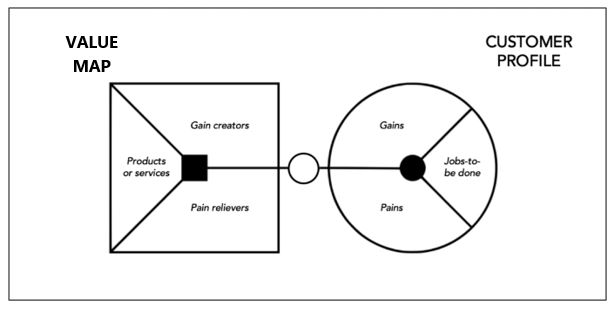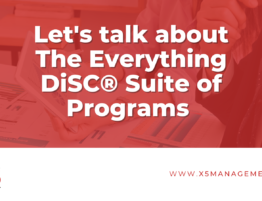
What is a Value Proposition?
A Value Proposition is a clear statement about the outcomes a client can gain, or benefit from, by using your product, service, or solution. Think of how a client would answer these two simple questions:
- What’s in it for me? (the client)
- Why should I buy from you? (and not your competitor)
Answering these questions will give you a foundation for creating key messaging around your overall brand development.
Creating a Value Proposition Canvas
The Value Proposition Canvas is a framework and business tool that helps ensure a product or service is positioned around the client’s values and needs. The tool was created by Alexander Osterwalder, Yves Pigneur, and Alan Smith in 2004. There are several segments in the canvas, and questions are posed for each segment to help identify various elements of the client/product relationship.

Here is how the canvas is broken down:
The circle represents the client profile. Generally, here’s where you should start. There are three components to the client profile:
1. Jobs-to-be-done: What a client needs to get done in their work or personal lives. Jobs include all the tasks that clients are trying to solve. It can include a problem being solved, a task being achieved, or any other need they want to satisfy. Jobs can be social, emotional, or functional. An example may be purchasing an article of clothing.
-
- Social “Jobs”– Does the article of clothing represent a social status or position? (i.e. a bespoke custom-tailored suit versus an off-the-rack inexpensive suit?
- Emotional “Jobs” – Come from our preferences, likes, and dislikes. With buying an article of clothing, it might be colour preference, style preference, or the feeling we want to get when we wear it.
- Functional “Jobs” – This would be the actual task of the purchase and the ease of convenience in doing so.
Some of the questions to consider:
-
- What does your client expect from you?
- How do you meet and exceed these expectations?
- What benefits does your client experience from you?
2. Gains: Gains include the positive experiences and desires that the clients wish to achieve. However, gains aren’t the opposite of pains. They are aspects that encourage users to adopt a product or service. Using the example of purchasing an article of clothing, it may be a specific brand or a specific store that satisfies their positive shopping experience. Some questions to ponder:
-
- What makes the client happy?
- What emotional need do you fulfil?
- How does your relationship with your client make their life easier?
- What would simplify the work or life of your client? (more services, lower cost, new features, etc.)
- What positive social consequences do your client want to get?
3. Pains: Any factor that prevents a client from completing a job is called a “pain”. Imagine them as roadblocks that clients have to deal with. Pains also include negative outcomes that clients prefer to avoid. This step helps to identify problems from a client’s perspective. Using the analogy of purchasing an article of clothing, pains may be price (perceived value), potential social conflict, (are the store’s values misaligned with societal values), or convenience of purchase (online versus in-store). Some questions to ponder:
-
- How do you and your products offer solutions to client problems?
- How have your competitor’s products/services not met client needs?
- What products or services can you offer that remove roadblocks?
The Value Map – The square on the canvas represents the Value Proposition Map. Like the circle, this is also divided into three parts:
-
- Products or Services – The place to list all your products, services, features, and benefits. Focus on how the features will help clients get their job done.
- Gain Creators – Anything that offers something new or improves the user experience.
- Pain Relievers – Anything that removes a client’s current frustration. These should be relevant to the pains mentioned in the client profile.
Using the Value Proposition Canvas
There are several opportunities to utilize this Value Proposition Canvas. These may be:
- Creating a new feature – by examining your Client Profile and identifying the “jobs” they need to accomplish, what might simplify their work or life (gain), and what products or services might remove some of their pain, you can better identify how a new product or feature will satisfy their needs.
- Entering a new market – this exercise can help you identify gaps in satisfying clients’ needs, or where your competitors are missing the mark.
- Market strategy – by conducting a Value Proposition exercise, you can clarify or validate assumptions you have about your clients and refine your marketing strategy that highlights how your product/service offers gains and reduces pains to your client.
- Beta test a new product – conducting a Value Proposition Canvas can help you beta test a new product to identify a potential market and a fit for their needs.
Points to Ponder When Conducting a Value Proposition Canvas Exercise
- Be the client – try to put your feet into their shoes and determine what jobs they need to accomplish, what are their pains in achieving those jobs, and where can you offer gains to make those experiences more fulfilling and satisfying.
- Segment your client base – not all clients are the same. Shrink your canvas to fit a specific client segment that will help you better identify their jobs, pains, and gains.
- Be realistic – not all pains can be removed, nor all gains achieved. Try to prioritize where the biggest wins can be in reducing pains and enhancing gains.
Conclusion
A Value Proposition Canvas is another tool in the tool chest to help businesses and organizations better understand their clients and their relationship with them to their products and/or service. If used properly, it forces business leaders to ask hard questions and look at their products/services through a new lens: the client’s lens. By going through this exercise you will have a better understanding of the “why”; why are you creating a new product, entering a new market segment, or modifying your current practices?
Interested in our Strategic Planning sessions?
Most organizations have a vision for a ‘better future’, but few invest the time and resources to plan out ‘how’ they will achieve that better future. That is why now, more than ever, there’s a need for strategic planning in business.
Schedule a complimentary Discovery meeting!









Write a comment: